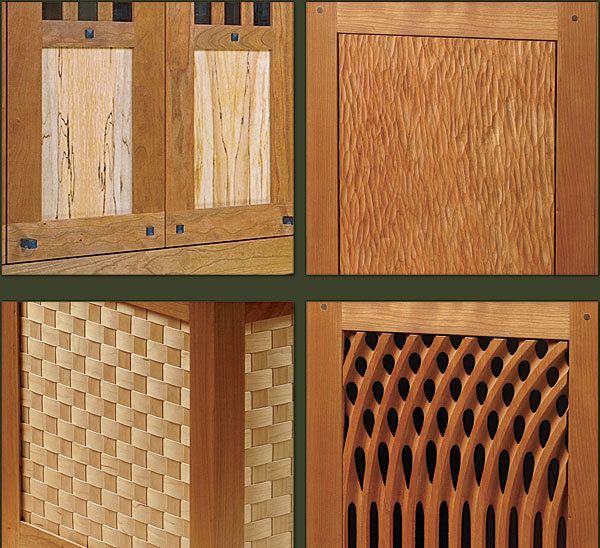4 Ways to Make Panels Pop
Doors are dominant on most cabinet designs, so dressing up door panels is an easy way to make furniture stand out.
Synopsis: Doors are dominant on most cabinet designs, so dressing up door panels is an easy way to make furniture stand out. And because they are flat and finite, panels are a great place to try out new techniques. This collection of articles shows four panels that are tasteful without being overwhelming: book-matched, hand-carved, woven, and routed.
About 30 years ago, when I worked in the finishing shop of the late george nakashima, he told me, “Our job as woodworkers is to reveal the tree’s inner beauty.” that’s literally what you do when you resaw a plank on the bandsaw and book-match the halves. Opening the two pieces like a book exposes a mirror image of color, grain, and texture—a natural pattern unique to that tree. Book-matching works well for all types of panels, including tabletops and all kinds of veneered panels, but my focus here is solid-wood door panels.
A good match takes planning
If you could slice a board perfectly, without removing any wood, you’d have the ideal book-match—a perfect mirror image. But you can only achieve near-perfection because the board loses some material when you saw it apart, flatten it, and make it smooth enough for furniture. So the goal is to remove as little wood as possible.
Begin by looking up and down the plank. You could surface it first, but with practice, you can train your eye to see through the rough surface to find interesting grain patterns and the like. Try using a mirror to see what the final match will be.
Don’t let the wood rule you. While the seam of the book-match is often centered in the door frame, that’s not an ironclad rule. an offset match is often more subtle than a centered match and creates a bit of visual tension, especially in paired doors or a run of cabinets. With flatsawn wood, I usually orient the points of the arches or any other predominant grain patterns toward the top of the panel. Be thoughtful with figured wood, too. for example, the fine, black lines of spalted wood can overpower a door if positioned in the center. try moving the interesting pattern toward the edges to create some visual tension. let the patterns emerge by butting two matched pieces together and trusting your eye.
From Fine Woodworking #211
For the full article, download the PDF below:
Fine Woodworking Recommended Products

Circle Guide

Blackwing Pencils

Dividers





















Log in or create an account to post a comment.
Sign up Log in